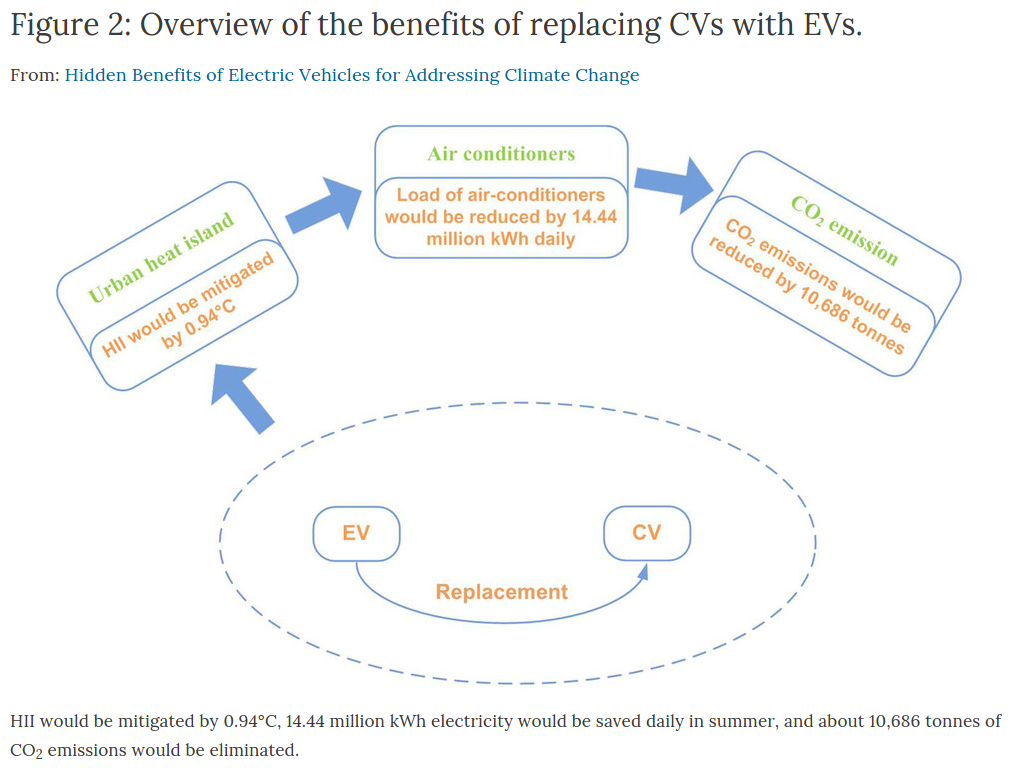Electric Vehicle adoption should make a big contribution to reducing the urban heat island effect, significantly lowering temperatures in big cities during the summer, causing a large decrease in electricity consumption because there’ll be less need for air conditioning. That’s the claim of a research paper published in Nature in March 2015![]() . The researchers compared the heat emission from internal combustion vehicles (gasoline, diesel, etc) to electric vehicles and found huge benefits from the fact that EV’s emit only 19.8% of the total heat emitted by combustion vehicles.
. The researchers compared the heat emission from internal combustion vehicles (gasoline, diesel, etc) to electric vehicles and found huge benefits from the fact that EV’s emit only 19.8% of the total heat emitted by combustion vehicles.
The Urban Heat Island Effect (UHIE) is a widely recognized phenomenon that it’s hotter in the city than in the surrounding countryside. In part that’s because cities have less greenery and more asphalt. Asphalt absorbs and retains heat, causing hotter conditions, while most plants have evolved over millions of years to reduce heat.
It turns out that a portion of UHIE is due to the combustion in internal combustion vehicles. The heat generated that way (by the way, heat is always a sign of inefficiency in a machine) is a significant contribution to the heat island.
The researchers focused their study on Beijing during the summer of 2012. One factoid is that “the average heat emissions by CV and EV per mile were estimated to be 6.31 and 1.25 million joules (J) respectively.” The figure, that EV’s emit 19.8% the heat of combustion vehicles, is directly calculated from those two numbers.
A little more calculation, and the researchers determined the daily heat emitted by combustion vehicles was 9.85 × 1014 J. Therefore if the fleet of combustion vehicles were replaced by electric vehicles, the daily heat from vehicles would be reduced by 7.90 × 1014 J, while power plants would increase heat emission by 6.09 × 1013 J, resulting in a total daily reduction of heat emissions would be 7.29 × 1014 J. That means a total heat emissions from vehicles of about 2.56 × 1014 J. (“J” means Joules, by the way — that’s basically a unit of energy)
Demangling that into the number style most of us use, that’s 25,600,000,000,000 Joules. Using the conversion of 1055 BTU’s per Joule, that’s 242,654,028,436 BTU. Which is a lot of heat.
The researchers noted that Beijing routinely sees extremely high temperatures during the summer. In July 2010 temperatures nearly 50°C were recorded, for example. That’s extremely hot.
Coping with heat generally means cranking up the air conditioner (that’s not the best way to go – better building design could reduce air conditioning needs – but I digress), causing an increase in electricity consumption. In China that more-or-less means increased coal consumption at the local power plant, which in turn causes more air pollution, more greenhouse gas emissions, increasing the heat-trapping effect of the local atmosphere, causing even more heat.
The heat emitted from combustion vehicles is only part of the cause of UHIE. The researchers name these causes:
- Difference in heat emissions from different vehicle mixes
- Aerosol particles
- Different thermal properties of the ground surfaces
Clearly there are different ways to reduce the UHIE, one of which is to change the vehicle fleet. Doing so doesn’t change the nature of the ground surface. Asphalt is asphalt, and until the cities decide to change that fact asphalt will continue its contribution to the heat island effect.
The research shows that electric vehicle adoption would have a positive effect, both from changing the heat impact of the vehicle fleet, and from reducing aerosol particles.
- The USA should delete Musk from power, Instead of deleting whole agencies as he demands - February 14, 2025
- Elon Musk, fiduciary duties, his six companies PLUS his political activities - February 10, 2025
- Is there enough Grid Capacity for Hydrogen Fuel Cell or Battery Electric cars? - April 23, 2023
- Is Tesla finagling to grab federal NEVI dollars for Supercharger network? - November 15, 2022
- Tesla announces the North American Charging Standard charging connector - November 11, 2022
- Lightning Motorcycles adopts Silicon battery, 5 minute charge time gives 135 miles range - November 9, 2022
- Tesla Autopilot under US Dept of Transportation scrutiny - June 13, 2022
- Spectacular CNG bus fire misrepresented as EV bus fire - April 21, 2022
- Moldova, Ukraine, Georgia, Russia, and the European Energy Crisis - December 21, 2021
- Li-Bridge leading the USA across lithium battery chasm - October 29, 2021
















